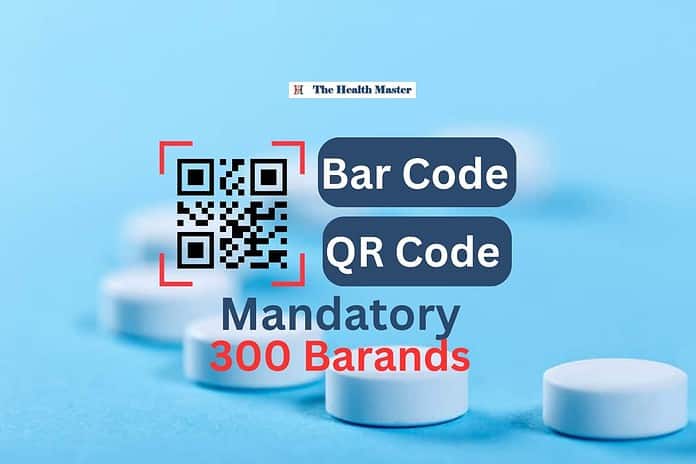Last Updated on January 6, 2025 by The Health Master
Bar Code or QR Code
The Indian drug regulator has announced a new rule, to be effective from August 1, 2023, that mandates the printing of bar code or QR Code (Quick Response code) on the labels of the top 300 brand drugs.
This move comes after the Union health ministry issued a final notification on November 17, 2022, amending the Drugs Rules, 1945.
The decision is in alignment with the recommendation of the Drugs Technical Advisory Board (DTAB) made in November of the previous year, which aimed to improve tracking and tracing of these drugs throughout the manufacturing and supply chain.
Key Points:
1. Implementation of Barcode and QR Code:
- The Central Drugs Standard Control Organisation (CDSCO) has confirmed that all batches of drug formulations for the specified top 300 brands, manufactured on or after August 1, 2023, must have a bar code or QR code on their labels.
- This requirement applies to drug manufacturers both within India and those importing products into the country.
- For imported products, it is preferable to have the bar code or QR code already affixed or printed on the label. However, if this is not possible, the code may be added in-country after obtaining permission from the licensing authority, as per the Drugs Rules, 1945.
2. Mandatory Information for Bar code or QR Code:
The drug manufacturers must include specific particulars in the bar code or QR code. These details are:
- Unique product identification code
- Proper and generic name of the drug or brand name
- Name and address of the manufacturer
- Batch number
- Date of manufacturing
- Date of expiry
- Manufacturing license number
3. Unique Product Identification Code:
- Each manufacturer will decide its own Unique Product Identification Code based on their Standard Operating Procedure (SOP) to ensure product identification.
- While the 300 specified brands must have the code printed, other manufacturers are welcome to voluntarily affix or print the code on additional brands.
4. Inadequate Space on Packaging Label:
- If the primary packaging label lacks sufficient space to accommodate the code, it can be affixed or printed on the secondary package label.
List of Drugs Covered:
The list of 300 drugs, along with others including:
- Certain strengths of Aciloc,
- Actemra,
- Allegra,
- Amlokind,
- Ascoril D Plus New,
- Asthalin inhaler,
- Becosules capsules,
- Betadine ointment, solution and gargle,
- Calpol,
- Combiflam,
- Dolo 650 mg,
- Electral Sache,
- Fabiflu,
- Foracort,
- Gelusil,
- Glycomet,
- Janumet,
- Lantus.
Background:
1. DTAB’s Recommendations:
- In November 2021, the DTAB proposed the introduction of bar code or QR code for the top 300 drug products in the Indian market to facilitate tracking and tracing.
- Prior to this, in May 2018, the board discussed introducing a trace and track mechanism on a voluntary basis for major 300 pharmaceutical brands. Some pharmaceutical companies had already implemented bar coding systems in some brands.
2. Government’s Actions:
- The Ministry of Health and Family Welfare (MoHFW) published a draft notification in August 2019, mandating QR codes for active pharmaceutical ingredients (APIs) based on DTAB recommendations. However, industry objections were raised and are being examined.
- An Inter-Department Committee (IDC) was formed in July 2020 to explore the implementation of bar codes/QR codes on drug and medical device packaging. As per the IDC’s recommendations, the top 300 drug formulation brands were selected for the first phase of implementation.
Roadmap:
- A roadmap was devised, involving the identification of the top 300 brands using suitable technologies, considering factors such as cost, procurement of hardware, changes in packaging lines and materials, and stakeholder consultation.
- A committee was established to oversee the execution of these activities.
Conclusion:
The forthcoming implementation of bar codes or QR codes on the labels of the top 300 brand drugs in India aims to enhance the tracking and tracing of pharmaceutical products throughout the supply chain.
The move is part of the government’s efforts to ensure drug safety, improve transparency, and combat counterfeit drugs.
Bar code or QR code for 300 brands: Govt notifies these drugs under Schedule H2
Pharma Industry to Ministry: Launch portal for QR codes for top 300 drug brands
Bar code or QR code: Govt issues draft Rule to mandate on label of drugs
Govt shortlists top 300 Drug Brands to introduce QR codes
DTAB recommends Bar code on top 300 brands of drug products
IDMA proposes additional cost allowance for QR Code implementation
Govt asks Pharma Industry to go for QR code instead of SMS code
QR codes on Schedule H2 drugs: Addressing the issues of counterfeiting
USFDA concludes inspection at Eugia Pharma with zero observation
The need for uniform pricing of Medical Devices and Surgical Products
USFDA gives approval for Plerixafor injectionTypes of inspections done by USFDA: Read in detail
Title: CDSCO asks to submit online applications for Veterinary Vaccine and drug test
An overview of Legislative Bills related to Pharma in the ongoing Parliament Session
Drug alert: 48 out of 1273 samples declared as NSQ in June 2023
Indian Pharma Industry wants to end multiple inspections by USFDA
Govt asks Medical Stores not to sell painkillers without prescription: Delhi
AHUs, Air Types, Air Changes and their Functions in Pharma Industry
For informative videos by The Health Master, click on the below YouTube icon:
For informative videos on Medical Store / Pharmacy, click on the below YouTube icon:
For informative videos on the news regarding Pharma / Medical Devices / Cosmetics / Homoeopathy etc., click on the below YouTube icon:
For informative videos on consumer awareness, click on the below YouTube icon:









